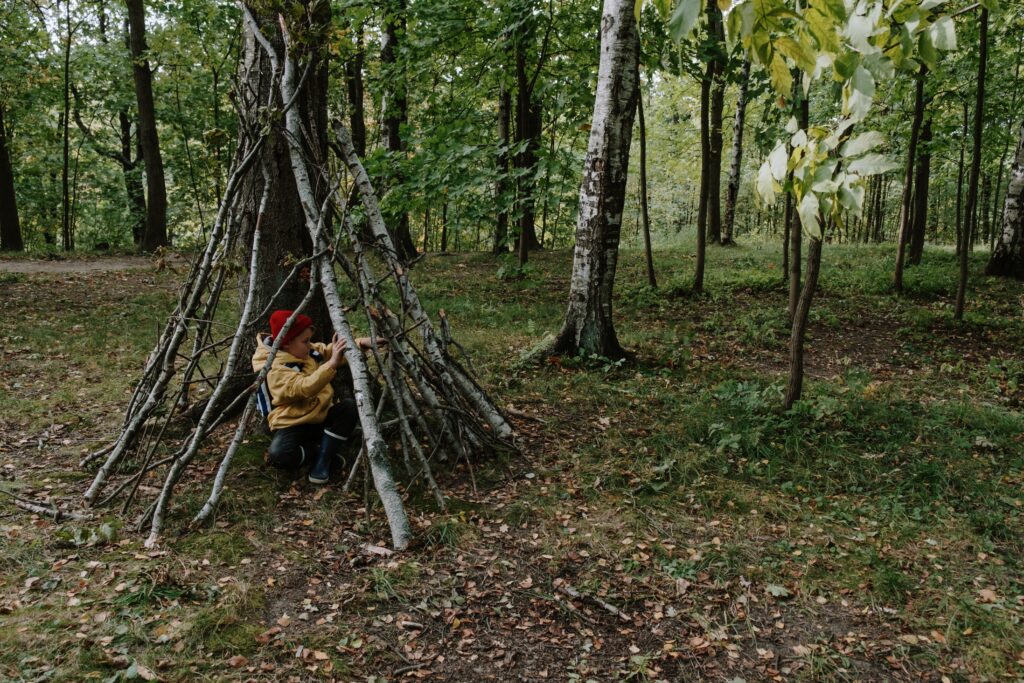The process of setting up a camp in the wilderness without the use of a prefabricated tent can be difficult, but it’s also a rewarding and enjoyable experience. The following is a list of steps that you can follow:

Select a location: Search for an area that is level, free of moisture, and sheltered from both wind and precipitation. Campers should steer clear of areas close to water sources and animal trails.
Choosing a Location:
- Search for an area that is dry, level, and free from any sharp or rocky objects that could damage your shelter or make it uncomfortable to sleep on.
- If you want to minimise the possibility of upsetting wildlife or luring animals to your campsite, you should try to avoid setting up camp near animal trails or water sources.
- Make every effort to locate a spot that is protected from the sun, the wind, and the rain. When camping in an area, it is important to look for spots that have natural windbreaks like trees, rock formations, or hills; be aware of any local regulations and obtain any necessary permits before setting up camp there.
Collect materials: In order to construct your shelter, you will need to collect materials such as branches, leaves, and grass. Find some strong branches to use as the framework for the fort, and some softer materials to use as the bedding and insulation.
Construct the framework: To construct the framework for your shelter, make use of sturdy branches. Put the branches up against each other so that they make the shape of an A-frame or a triangle.
Putting Together a Structure:
- Once you have located a spot that will work for your shelter, the first thing you should do is select some sturdy branches or logs to use as the primary support beams.
- To form the fundamental outline of your shelter, lean the primary support beams against a nearby tree or rock outcropping. It is important that the main beams be of sufficient length to allow for sufficient headroom, as well as to support the frame without bending or breaking.
- After you have installed the primary support beams, you can begin adding smaller branches and twigs to form a lattice pattern. To build a sturdy structure, intertwine the smaller branches with the main support beams using a weaving pattern.
- Natural cordage, such as vines or strips of bark, should be used to secure the branches to one another. If you have access to paracord or any other type of synthetic cordage, you can use that instead.
- To make the structure more stable, you should: • Stuff smaller twigs and leaves into any spaces or holes in the frame; • To make the structure more stable, you should: •As soon as you have the fundamental framework assembled, you can begin adding layers of insulation and a cover to protect from precipitation as necessary.
Add insulation: Once you have the frame, you can add insulation by layering softer materials such as leaves, grass, and pine needles over the branches. This will prevent the heat from escaping. This will help keep you warm and prevent you from getting wet.
Make a bed: Make yourself a cozy bed by piling on more grass, leaves, and other pliable materials on top of the insulation layer. This will give you plenty of cushioning.
Install a rain cover: If there is a chance that it will rain, install a cover that is waterproof over your shelter. To cover your shelter, you could make use of a tarp, a poncho, or even some large leaves.
Construct a fire pit: In order to cook food and keep warm, construct a fire pit some distance away from your shelter. It is imperative that the area be cleared of any combustible materials, and rocks should be used to contain the fire.
Keep in mind that you should always put the Leave No Trace principles into practise and leave the area in better condition than when you found it. Before setting up camp in the wilderness, you should make sure to check any applicable local regulations and acquire any necessary permits.





